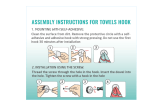
INSTALLATION INSTRUCTIONS
for Wood Patio Doors with Exterior Trim or Nailing Fin (JII026)
2
FULLY SHEATHED WALL CONSTRUCTION
The wall framing is
covered by sheathing
and the door will be
mounted with the
nailing n/exterior
trim ush against
the sheathing. This
installation assumes
building wrap is
properly installed
prior to installation.
OPEN-STUD CONSTRUCTION
The wall framing needs to be covered by backing support before the
patio door can be installed. The door will be mounted with the nailing
n/exterior trim ush against the applied backing support.
This backing support should be a non water-degradable, thin (max. 1/8"
thick) sheet material such as vinyl sheeting. Completely surround the
rough opening with the backing support as shown. Backing support
must be applied before building wrap.
This installation guide specically addresses masonry/block wall,
sheathed wall and open-stud construction.
MASONRY/BLOCK WALL CONSTRUCTION
This installation
assumes that a
building professional
has already properly
fastened and sealed
a framework of studs
(often called a buck)
to the concrete/
masonry wall.
MATERIALS
Finned products: 1 3/4" galvanized roong nails; Exterior trim •
products: 3" galvanized casing nails. Fasteners must penetrate at least
1" into framing.
3/16" x 2 1/2" self-tapping concrete screws (for concrete suboors)•
Builders doors with a berglass sill will include a square drive bit, •
9 - #8 x 1.5" screws for wood suboors, 4 - #10 x 3" strike plate and
2 - #8 x 2" head bracket replacement screws.
Non water degradable or compressible shims•
JELD-WEN 6" wide self-adhesive ashing (part #08987) or equivalent •
(9" if required by local code)
Protecto Wrap Safseal Systems 5500 spray adhesive/primer (or as •
recommended by the self-adhesive ashing manufacturer)
Polyurethane low expansion foam•
NEEDED MATERIALS & TOOLS
Sealant (100% polyurethane if painted, 100% silicone if left exposed) •
and backer rod
Plastic drain screen with crisscross or woven pattern (sold in 6" widths •
to protect rain gutters) for step-down landings
Sheet metal ashing or bendable vinyl sheeting for sill pan (6" wide •
for 2" x 4" wall)
Note! Follow all material manufacturers’ instructions for proper use
and compatibility.
TOOLS
Cutting shears •
(sill pan)
Tape measure•
Utility knife•
Level (4' minimum •
recommended)
J-roller•
Caulking gun•
Drill•
Construction stapler•
Flat head screwdriver•
SAFETY
Read and fully understand ALL manufacturers’ instructions before •
beginning.
Do not work alone. Two or more people are required. Use safe lifting •
techniques.
Use caution when handling glass. Broken or cracked glass can cause •
serious injury.
Wear protective gear (e.g. safety glasses, gloves, ear protection, etc.).•
Operate hand/power tools safely and follow manufacturer’s operating •
instructions.
Use caution when working at elevated heights.•
SAFETY & HANDLING
MATERIALS & PATIO DOOR HANDLING
Make sure the operating panel is secured prior to installation.•
Heed material manufacturers’ handling and application instructions.•
Protect adhesive surfaces from dirt, moisture, direct sunlight and •
folding over onto themselves.
Handle in vertical position; do not drag on oor.•
Do not put stress on joints, corners or frames.•
Store patio door in dry, well-ventilated area in vertical, leaning •
position to allow air circulation; do not stack horizontally.
Protect from exposure to direct sunlight during storage.•
Install only into vertical walls and when conditions and sheathing are •
dry.
IF INJURY OCCURS, IMMEDIATELY SEEK MEDICAL ATTENTION!
ROUGH OPENINGS
Buck
Trimmer
studs
Header
Sheathing
Sill area
King
stud









